|
|
Leamington

|
|
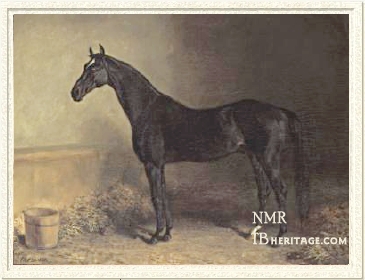 |
|
|
Leamington was the most influential stallion imported into the U.S. in latter half of the nineteenth century. He was the first stallion to dethrone the great Lexington as America's leading sire, and his sireline went on several more generations with influence for both speed and stamina.
Leamington was bred in England by Mr. Halford. He was a brown horse, later almost black, with excellent conformation and especially fine hind legs. His sire was Faugh-a-Ballagh (1841, by Sir Hercules), a full brother to the influential stallion Birdcatcher. Faugh-a-Ballagh was a good stayer who had won the Doncaster St. Leger, the Grand Duke Michael Stakes, and Newmarket's Cesarewitch Stakes. Sent to France in 1855, there he got the great filly, Fille de l'Air, winner of both the Epsom Oaks and its French equivalent, the Prix de Diane, and a number of other races on both sides of the channel. Leamington's unnamed dam, who had been bred by the Marquis of Westminster, was by Pantaloon, sire of the stayers Legerdemain and Elthiron, the exceptionally fast Sleight of Hand, Oaks winner Ghuznee and St. Leger winner Satirist, among other good winners. Leamington's dam was out of Daphne, a daughter of the great Cup horse Laurel, a son of Blacklock.
As a runner Leamington demonstrated gameness, speed and staying ability. He started his career at age two, intially in the name of his breeder, but was sold on to a Northampton innkeeper, Mr. Higgins, who placed him under the care of Tom and Edward Parr. He won his first outing, the Woodcote Stakes at Warwick, but was beaten in the Robin Hood Stakes at Nottingham, the Bunney Park Stakes, York's Convivial Produce Stakes. In his next outing at Derby, he won the Chesterfield Stakes, and was retired for the year.
His first scheduled outing at age three was the Epsom Derby, but he contracted strangles and this affected his second season. His connections began to steer him towards the handicaps, and it appears they manipulated his performances to lengthen the odds and keep his weight down, when he was finally allowed to win. He lost four small races in succession, carrying light weight, then won a half mile race at Wolverhampton. Another string of losses ensued -- the Town Plate at Warwick, a half-mile handicap at Leicester, the Corporation Plate at Shrewsbury -- and then he was allowed to win the one-mile Stewards' Cup, carrying 98 pounds.
His next race, at age four in 1857, was the 2-1/4 mile Chester Cup, in which he was assigned 93 pounds. He had developed a reputation as a non-winner that could not stay, and went off at odds of 6 to 1 in a field of thirty-five. His jockey, David Hughes, had been instructed to keep Leamington "out of the crowd," and "when you have gone two miles call upon Leamington, and he will bring you through," which he did, winning "in a walk." In his next race, the Ascot Gold Cup, he ran unplaced to three three-year-olds, Skirmisher, Gemma di Vergy, and Saunterer. This was followed by the 2-1/2 mile Goodwood Stakes, carrying 118 pounds to the favored Fisherman's 124 pounds. With odds of 100 to 3 and a field of nineteen, Leamington won easily by a length, beating the three-year-old Gunboat, carrying 91 pounds, with Fisherman unplaced, reaping a tidy sum for his connections, who had wagered heavily on him. His next race was the Chesterfield Cup, also at the Goodwood meeting, where he was top-weighted at 131 pounds, and was defeated. Fisherman beat him in the next race, a Queen's Plate at Egham, his last race of the season.
At age five he was brought out once, for the 2 mile-2 furlong Cesarewitch; by this time Admiral Rous, who handicapped the races, "had found him out," and gave him 130 pounds to carry, 30 more than the American-bred Prioress, who was the same age, and 42 more than Rocket, who won.
At age six he came out first for the Chester Cup, again, carrying 114 pounds to Fisherman's 126 pounds, in a field of thirty-two, that included such top horses as Prioress, Lifeboat, and Underhand. He started poorly, a serious problem in the tight-turns of the Rhodee, but he made up the ground "without any apparent exertion, and won in a canter by two lengths." The next two horses in were the four year olds Herne (receiving 26 pounds from Leamington) and Botany (receiving 38 pounds). His next race was the Queen's Gold Vase at Ascot, where, carrying 131 pounds, he ran second to Schism, carrying 34 pounds less. He did not place in the Goodwood Cup, and came out of the race with his off-foreleg injured. The following Spring his owner challenged for The Whip, to be run in October over four miles with 140 pounds up. During his preparation he broke down, and was retired to Rawcliffe Paddocks to begin his stud career in 1860.
Leamington in the Stud
At Rawcliffe, standing next to St. Leger and Goodwood Cup winner Newminster (Touchstone - Bee's Wing), he got nineteen winners of forty-two races in three seasons, none of them exceeding $2,000 in value. One of his foals, Spa (1862, from Satanella, by Newminster), was imported into Victoria, Australia, where she produced several good runners, including Newminster (1873, by imp. The Marquis), twice leading sire in Australia.
In 1865, he was purchased for £1,575 by Sir Roderick W. Cameron, owner of the Australian Steamship Line, who had moved to Staten Island (New York, USA) in 1852 and was a founding member of the American Jockey Club at Jerome Park. Leamington was displayed at the Paterson (New Jersey) races in September of 1865, almost immediately after he arrived in the U.S. He became the object of infatuation of General Abe Buford, who talked Cameron into loaning him the elegant, nearly black stallion. Leamington stood the 1866 season at Buford's Bosque Bonita Stud, near Versailles, in Woodford County, Kentucky. One season at Bosque Bonita, servicing only thirteen mares, resulted in an outstanding crop which included the great champion LONGFELLOW, Buford's own ENQUIRER, besides LYTTLETON, LYNCHBURG, ANNA MACE and MISS ALICE.
Because he was poorly patronized, Cameron sent Leamington to his own Clifton Stud on Staten Island. He was moved to New Jersey in 1868, and in 1871 he was at John Hunter's Annieswood Farm, Westchester County, New York, by now his youngsters beginning to show their superiority on the turf. The Westchester foals of 1872 included RHADAMANTHUS, OLITIPA, JAMES A., HYDER ALI, and a red colt named ARISTIDES, winner of the inaugural running of a minor Midwestern event known as the Kentucky Derby.
Leamington found yet another admirer and a new home in 1872, when he was sold to Aristides Welch to stand at his Erdenheim Stud, at Chestnut Hill outside of Philadelphia, Pennsylvania. Here, Leamington held court until his death on May 6, 1878 at the age of 25. He was replaced by his own son, REFORM (bred by R.W. Cameron) the same season, and many of the Erdenheim crop that year were noted as being sired "by Leamington or Reform."
Leamington became the leading sire in America four times, for the first time in 1875, when his son ARISTIDES (c. 1872 out of Sarong by Lexington), named for Aristides Welch, won the first Kentucky Derby and was probably the best colt of his crop, although a disappointment as a sire. This leading sire title was a particularly important milestone since it marked the first time in 16 years that the great stallion Lexington had not topped top the American sires' list. Lexington came back to lead (for the last time) in 1876, but Leamington rose to the top again in 1877, 1879, and 1881. In 1875, six of his eight leading money earners were out of Lexington mares, and they were also the dams of the winners that led to his topping the lists in 1877, 1879, and 1881.
He had a reputation as a "man eater," and western turf writer Thomas Merry noted, due to his temper, he couldn't get near him when he saw him at Erdenheim, but Leamington's groom, John McClosky, said, "He was a horse of great high spirits and liked to show his heels when things did not suit him, but he was not vicious. I have often laid down in his box, when he would come up and rub his nose all over my face and lick it with his tongue. Of course he had his likes and dislikes." He had matured at 16-1/4 hands high, and was described as big, elegant, and powerful. He was a great stayer, and sired many progeny with superb stamina as well as many precocious juveniles, but they were not particularly sound, although they were gritty competitors (PAROLE was probably the soundest). Many were like their sire, very dark brown or black, and a little on the coarse side.
|
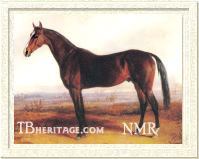
Longfellow. Used with permission by National Museum of Racing.
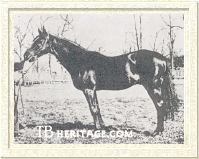
Iroquois, first American to win the Epsom Derby
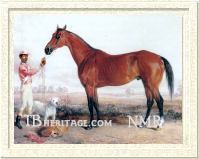
Enquirer. Used with permission by National Museum of Racing.
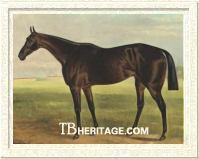
Parole, "Hero of Two Continents"
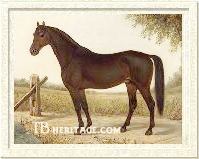
Hyder Ali.
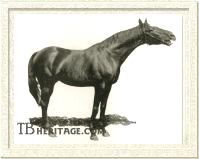
Sensation.
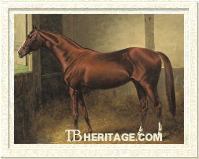
Sensation's brother Onondaga.
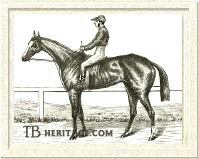
Olitipa.

Spinaway.
|
|
One of Leamington's best runners was LONGFELLOW (c. 1867 out of Nantura by Brawner's Eclipse), a legend in his own time, winner of 13 races including the Saratoga Cup and the leading sire himself in 1891. Longfellow's progeny included the great racemare Thora, dam of Yorkville Belle, three-time champion The Bard, and Kentucky Derby winner Leonatus, who lost one race as a juvenile and was never again beaten, and later a prominent sire of such horses as American Derby winner Pink Coat and Suburban Handicap winner Tillo.
Another particularly important runner by Leamington was IROQUOIS (c. 1878 out of Maggie B. B. by *Australian), who became the first American-bred to win the Epsom Derby. Iroquois also won the St. Leger Stakes and became America's leading sire in 1892.
Another son, ENQUIRER (c. 1867 out of Lida), was the best three-year-old of his generation, and sire of Bella B., Mannie Gray (dam of Domino), Napa and Alice Gray, Falsetto, and Inspector B. (winner of 9 out of 17 starts at 3), the latter sire of the great race filly Endurance By Right.
Leamington also sired the "hero of two continents," the gelded PAROLE (g. 1873 out of Maiden by Lexington), bred by Welch. His dam had won the second running of the Travers Stakes in 1865, a very rich purse of $3,400 her reward. Parole was sold to New Yorker Pierre Lorillard, and at age two, winning four of his six starts and a total of $8,500, he was the champion juvenile of his year. He went unplaced in the Kentucky Derby at age three, his first start of the season, where he did not place, and did not appear again until the end of July when he won a sweepstakes over 1-1/4 miles at Saratoga, beating Tom Ochiltree, who turned the tables four days later in the Saratoga Cup. His other wins at age three included the Sequel Stakes (1-3/4 miles) and the All-aged Stakes (1-1/2 miles) at Jerome Park, running second to Vigil in Baltimore's Dixie Stakes and second to him again in the Breckinridge Stakes.
At age four he was champion older horse in America, winning eight of his twelve starts,including the Woodburn Stakes over 2/1-2 miles, the Maturity Stakes over 3 miles, and the Saratoga Cup over 2-1/4 miles, beating Tom Ochiltree, Vera Cruz, and Athlene, a top race mare.
At age five he won the Cups at Baltimore, Saratoga, and Monmouth. In the fall Lorillard shipped him to England with Duke of Magenta, intending to use him as a trial horse for the younger rising star, but Duke of Magenta fell ill on arrival, and Parole was brought out to campaign. At age six, in 1879, he won the Newmarket Handicap, defeating the great cup horse,Isonomy. He went on to win Epsom's 1-1/2 mile City and Suburban Handicap, and the following day, carrying 124 pounds, the Great Metropolitan Handicap over 2-1/4 miles. A few weeks later he ran fourth in the Chester Cup (won by Reefer), and the next day won the Great Cheshire Stakes, carrying 134 pounds. His last race of the season was the Epsom Gold Cup, which he won. In the spring of 1880 he ran in the Liverpool Cup, carrying 131 pounds, and won the race, but was disqualified for "crossing." He ran second in the Epsom Gold Cup, and that fall was shipped back to the states, landing in New York in late September and on October 2 winning a mile race at Jerome Park. He won his three other races that fall season in the U.S.
Parole ran two more seasons: in 1881, age eight, he won twelve of his twenty-four starts, including the Westchester Cup and the Manhaattan Handicap, and at age nine, he won eight of his twenty-one races. In all this game and gallant horse, whose racing style was to lie off the pace and sprint at the finish, won $82,909.25, and fifty-nine of his 137 races.
Leamington also sired HYDER ALI (c. 1872 out of Lady Duke by Lexington), a good racehorse and sire of Spokane; SAUNTERER (c,1878 out of Lemonade by Lexington) winner of the Belmont and Preakness Stakes; HAROLD (c. 1876 out of Maggie B. B. by *Australian), champion at two and Preakness winner; RHADAMANTHUS (c. 1872 out of Nemesis by *Eclipse); POWHATTAN (c, 1879 out of Maiden by Lexington); and REFORM (c. 1872 out of *Stolen Kisses by Knight of Kars).
The great Lexington daughter, Susan Beane, produced three good horses to Leamington. First was SENSATION (1877), unbeaten two-year-old in eight starts. As a sire he only got selling platers until his owner, Pierre Lorillard, shipped some of his youngsters to England. In 1897 he had winners of £6,345, and in 1889, due largely to the victories of his sons Democrat and Doninie, he was second to Orme on the leading sires list in England, with winners of £12,096. He also sired Jean Beraud, the U.S. champion three year old of 1898.
Susan Beane's next colt by Leamington was ONONDAGA (1879), bred by Welch and sold to Leonard Jerome, later resold to the Dwyer Brothers. He won a $5,000 match against Sachem, and the July and Kentucky Stakes, but was retired with sore feet. In the stud he got a number of good horses, with winners of 169 races in 1892 and winnings of $107,082, putting him fifth on the leading sires list in the year Iroquois topped it, although Iroquois had far fewer winners. The third Susan Beane-Leamington son was STRATFORD (1873).
Leamington's son EOLUS (c. 1868 out of the great four-mile mare, Fanny Washington, by Revenue) was a small horse known as "the bull dog of the turf." He sired Morello, a very good juvenile and three year old; Eole, a top four year old who was shipped to England to run unsuccessfully in the Ascot Gold Cup (he later died in a fiery train crash enroute to Freddie Gebhardt's stud farm in California, adjacent to the Guenoc Stud Farm owned by his lover, Lily Langtry), and 1884 Preakness winner Knight of Ellerslie (out of Lizzie Hazlewood, by Scathelock), who in turn sired Suburban winner Henry of Navarre. <
|
LYTTLETON, a bay son from Leamington's first crop (1867, out of Lexington daughter Fannie Holton), proved to be a stout and game horse, won over one, two and four miles, his victories including the Louisville Hotel Stakes (4 miles, beating Defender), the Jockey Club Purse at Memphis (a two mile "dash"), the Association Purse at Lexington (two miles, he won this twice); the All-aged Purse in mile heats at Long Branch.
Among Leamington's many good daughters were the top race fillies SPINAWAY (f. 1878 out of Megara by *Eclipse), OLITIPA (f. 1872 out of Oleata by Lexington), and SUSQUEHANNA (f. 1874 out of Susan Beane by Lexington). SPINAWAY was a brilliant two year old, bred by Welch, and purchased by Pierre Lorillard, for whom she won seven of her nine races. Her career ended at age three, when a stone bruise went unnoticed, resulting in serious lameness. In the stud she produced Strideaway and Lazzarone (by Spendthrift), who beat Domino in the Suburban Handicap. OLITIPA, a bright chestnut with white legs, was a good juvenile, who won the Nursery and the Flash Stakes, the latter in record time, and at age three, running for her new owner August Belmont, she won the Ladies', Maryland, Alabama and Hunter Stakes. Other daughters included IROQUOIS' full sister, JACONET, who produced champion and leading sire Sir Dixon; and PERFECTION, a sister to PAROLE and POWHATTAN, who appears in the direct female line of Nearco (1935), Star Pilot (1943), Neckar (1948) and Pilsudski (1992).
--Patricia Erigero and Anne Peters
|
|
|
|

